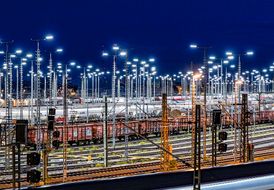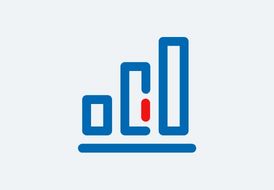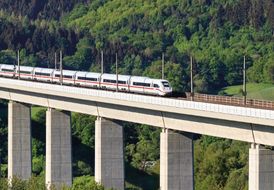Energy efficiency
Increasing energy efficiency is another component of achieving our climate protection target. In the short and medium term, we are also focusing on the use of hybrid drives in our locomotives and multiple units. In addition, we are continuously investing in the research and use of alternative drives and fuels, following the principle of being open to new technologies. Our measures to increase energy efficiency include, in particular, further electrifying our track infrastructure and reducing our energy consumption.
| SPECIFIC PRIMARY ENERGY CONSUMPTION BY DB GROUP JOURNEYS AND TRANSPORTS | 2021 | 2020 | Change | 2019 | ||
absolute | % | |||||
Regional rail passenger | 1.37 | 1.29 | +0.08 | +6.2 | 0.84 | |
in Germany | 1.34 | 1.23 | +0.11 | +8.9 | 0.83 | |
Long-distance rail passenger transport (MJ/pkm) | 0.35 | 0.40 | –0.05 | –12.5 | 0.23 | |
Bus transport (MJ/pkm) | 1.49 | 1.56 | –0.07 | –4.5 | 1.07 | |
in Germany | 1.66 | 1.74 | –0.08 | –4.6 | 1.29 | |
Rail freight transport | 0.30 | 0.29 | +0.01 | +3.4 | 0.33 | |
Road freight transport | 1.23 | 1.26 | –0.03 | –2.4 | 1.25 | |
Air freight (MJ/tkm) 3) | 9.29 | 9.06 | +0.23 | +2.5 | 9.79 | |
Ocean freight (MJ/tkm) 3) | 0.07 | 0.07 | – | – | 0.08 | |
Well-to-wheel (WTW); Scope 1 –3; rail transport companies are included with their own energy mix and/or European country mixes.
1) Up to and including 2020 excluding rail freight transport from/to China by DB Cargo and DB Schenker.
2) Up to and including 2020 excluding pre- and onward carriage from land, air, and ocean freight.
3) 2021 excluding pre- and onward carriage.
Due to the slump in train utilization caused by the Covid-19 pandemic, energy efficiency in passenger transport remained below the 2019 level in 2021. Compared to 2020, however, it has improved somewhat. We expect that as utilization increases, the 2019 level will be reached again and the positive effect of the fleets’ efficiency improvements will continue into the next few years. Since rail passengers in DB Long-Distance travel on 100% eco-power in Germany, DB long-distance rail passenger transport remained the most climate-friendly mode of transport in 2021. In addition, efficiency improvements were achieved in logistics.
Main levers for reducing our energy consumption are equipping our freight train locomotives with driving assistance systemsno. 08 such as LEADER at DB Cargo, RESY at DB Regional or the Eco app at DB Regional Bus. We are modernizing our electric vehicle fleets by adding new series that achieve greater energy efficiency. Our modern electric locomotives and multiple units also make a significant contribution to increasing energy efficiency by recovering brake energyno. 19. In 2021, the energy recovery rate increased slightly to 16.7% (previous year: 16.5%). The fleet of vehicles equipped with recovery technology is currently growing, for example through the addition of ICE 4 trains to passenger transport.
Stationary energy consumption
| ABSOLUTE PRIMARY ENERGY CONSUMPTION OF DB GROUP STATIONARY FACILITIES IN GERMANY / TJ | 2021 | 2020 |
| 2019 | ||
absolute | % | |||||
Rail network operation | 5,600 | 6,086 | –486 | –8.0 | 6,002 | |
Passenger stations | 2,640 | 3,693 | –1,053 | –28.5 | 3,856 | |
Maintenance of rolling stock (depots) | 2,539 | 3,007 | –468 | –15.6 | 2,978 | |
Other | 4,157 | 4,145 | +12 | +0.3 | 2,854 | |
Total | 14,936 | 16,931 | –1,995 | –11.8 | 15,690 | |
By using primary energy as a reference, we also take into account the upstream processes involved in providing energy, such as the extraction, treatment and transport of fuels or processes for generating electricity. Our about 5,400 stations, interlockings and operating facilities, our depots and buildings in Germany, DB Schenker’s more than 2,100 locations worldwide and the DB Arriva and DB Cargo locations in other European countries account for 6.5% of DB Group’s total primary energy consumption. In order to identify potential savings and measure energy consumption over the long term, energy audits were carried out at the Group companies as part of implementing the EUEnergy Efficiency Directive. DB Energie GmbH, DB Fernverkehr AG, DB Station&Service AG and DB Regio AG as well as many of their subsidiaries operate a certified energy management systemno. 78 in accordance with ISO 50001.



